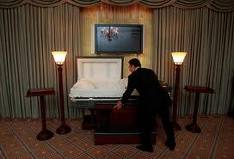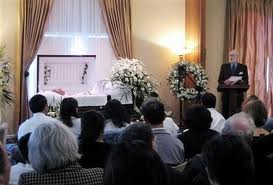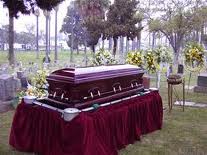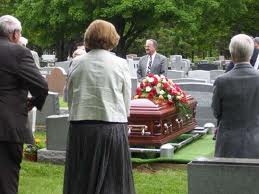US and Canadian Funeral Ceremonies
Within major parts of the US and Canada, funeral ceremonies can range from being a very simple memorial to an elaborate ceremony complete with horse drawn carriages. But, for the most part, any ceremony in these locations can be divided into the following areas:
The Funeral Wake, Visitation or Viewing
The Funeral Service
The Burial
The Funeral Wake, Visitation or Viewing

At the initial time of death, guests will come to pay their respects both at the home of the family members, as well as the funeral home where the body is displayed in the casket. The casket may surrounded with a large arrangement of flowers, provided by both family members and guests. A floral casket spray is usually placed on top once the casket is closed. If the decedent served in a branch of the Armed forces, the casket may be covered with a national flag; Oftentimes at a viewing, the casket is open and the deceased has been made up for the ceremony. The body is traditionally dressed in the decedent's best clothes, which may be slit up the back to facilitate dressing the body. In recent times, there has been more variation in what the decedent is dressed in. The body may be adorned with jewelry, including a watch (which may or may not be removed for burial and/or the cremation process). The body may also not be embalmed. The decision to embalm is mainly dependent upon the customs of the family, the amount of time the deceased has been dead and/or the requirements of the place of burial.
One of the features of the viewing is the presence of a guestbook. Visiting guest are expected to sign a book which is kept by the family members of the deceased. This book is often used to send thank you cards to the viewing guests. Viewers attending the service have a choice of whether or not to view the body in the casket. Also, family members can decide to have the casket remain closed, and instead display photographs, prized possessions or any other items of the deceased. Recently, many funeral services have begun creating DVD with pictures and video of the deceased which is played continuously throughout the service. After the service, this item is given to the family.
Friends of the deceased and other family members frequently send flowers and cards to the funeral home for the viewing service. Friends and loved ones are also welcome to stand and speak about the deceased as a way of honoring them. Thereafter, a prayer and sermon is usually given by the funeral service director or another invited guest of the clergy.
Note: For Irish descendants, an Irish Wake usually lasts 3 days. On the 4th day is the funeral service. During the wake period, family members and friends will ensure that there is always someone awake with the body, saying prayers.
The Funeral Service

The deceased is usually transported from the funeral home to a church in a hearse, a specialized vehicle designed to carry casket remains. The hearse is very often part of a procession, followed by any funeral service vehicles, and other private automobiles, all traveling to the service site. In a number of jurisdictions, special laws cover funeral processions - such as requiring other vehicles to give right-of-way to a funeral procession. Some funeral ceremony vehicles are equipped with light bars and special flashers to increase their visibility on the roads. After the funeral ceremony, the procession proceeds to either the burial site or the crematory if the deceased is to be cremated.
A traditional funeral ceremony usually consists of prayers, readings from the Bible or other sacred texts, hymns and songs, and words of comfort and a eulogy by the clergy. Sometimes a friend or relative would be asked to give the eulogy, as they are most familiar with details related to happy memories and accomplishments of the deceased. It is also during the service that guests are invited to have a final opportunity to view the deceased if the service is an open casket service. Guests are usually followed by family members and the spouse last.
Note: In some religious denominations (e.g. Roman Catholic and Anglican), in order to preserve respect for traditions, eulogies at funeral ceremonies are prohibited or discouraged. In addition, the coffin is traditionally closed at the end of the wake and is not re-opened for the funeral ceremony.
Depending upon the custom, the music played during a funeral ceremony will vary. For instance, at Irish funerals, bagpipes may sometimes be played. During a baptist funeral, the music may be gospel. Additionally, any type of noise other than quiet whispering or mourning during any part of the service may be considered a sign of disrespect.
Once the funeral ceremony has ended, the burial will follow. In many religious traditions, pallbearers, usually close males who are unrelated to the deceased, will carry the casket from the funeral home or church to the hearse, in preparation of the trip to the burial site. The pallbearers may sometimes sit in a special reserved section during the memorial service.
The Burial

In many instances, the burial service will immediately follow the funeral service. The funeral procession will travel from the site of the memorial service to the site. If the deceased served in the Armed forces, military rites will often be accorded at this site.
According to most religions, the casket remains closed during the burial ceremony. In Eastern Orthodox funerals, they are reopened just before burial to allow loved ones to look at the deceased and offer a final farewell. A final prayer may be said and the deceased is placed into the burial area. Morticians will typically ensure that all jewelry worn by the deceased are in the casket before it is buried or entombed. If the body is to be cremated, these items may remain or be removed prior to the process. Any pacemakers must be removed prior to cremation as they could explode and cause damage to the crematorium.
After the Service
In many traditions, a meal or other gathering follows the burial service. This gathering may be held at a church or in the home of the deceased or other family member.
Private Funeral Ceremonies

- The deceased was an infant.
- The deceased was a high profile person (crime victim, convicted criminal, celebrity, etc) in which case, the service is made private either to avoid unwanted media coverage or intrusion.
- The family is unable to endure a traditional service and wants a quiet, simple funeral which includes only the most important people of the deceased's life.
- It is part of preplanned arrangements to have a simple, more cost effective service rather than that of traditional arrangements.
In some cases, the family may schedule a public memorial service at a later time.
Funeral. (2008, March 24). In Wikipedia, The Free Encyclopedia. 2008, from http://en.wikipedia.org/w/index.php?title=Funeral&oldid=200414745
 See also:
See also:New Orleans Jazz Funerals
East Asian Funerals
Ancient Funerals
Viking Funerals
Online Funeral Services
Military Funerals
| Funeral Guide | Find a Funeral Home | Send Flowers |